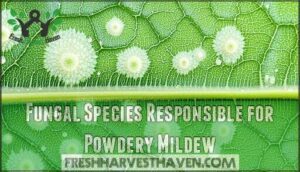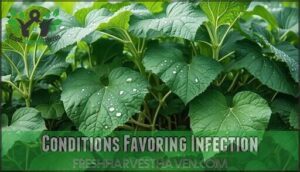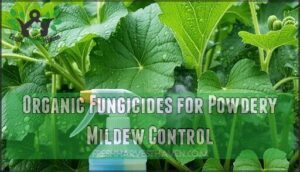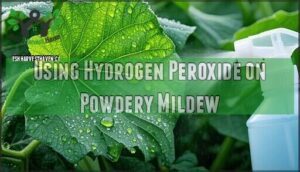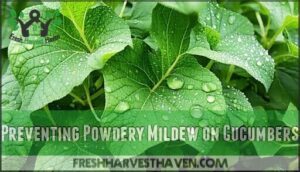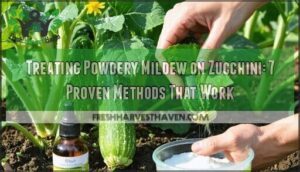This site is supported by our readers. We may earn a commission, at no cost to you, if you purchase through links.
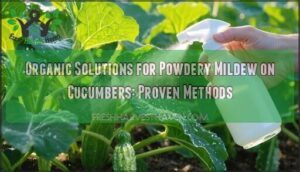 You’ve got several proven organic solutions for powdery mildew on cucumbers that’ll save your harvest.
You’ve got several proven organic solutions for powdery mildew on cucumbers that’ll save your harvest.
Mix one part milk with nine parts water and spray weekly—the proteins create an antifungal barrier. Baking soda works too: dissolve 1 tablespoon per gallon of water with a drop of dish soap for coverage.
Hydrogen peroxide (3% solution diluted 1:10) delivers oxygen atoms that destroy fungal cells on contact. Apply these treatments early morning or evening to avoid leaf burn.
Sulfur-based fungicides and neem oil provide additional protection. Space plants properly for air circulation, and water at soil level to prevent moisture on leaves.
The timing of your applications makes all the difference.
Table Of Contents
- Key Takeaways
- Causes and Symptoms of Powdery Mildew
- Types of Plants Susceptible to Powdery Mildew
- Cultural Controls for Powdery Mildew Prevention
- Natural Remedies for Powdery Mildew
- Organic Fungicides for Powdery Mildew Control
- How Hydrogen Peroxide Works to Destroy Powdery Mildew
- Using Hydrogen Peroxide on Powdery Mildew
- Additional Treatments for Powdery Mildew Control
- Preventing Powdery Mildew on Cucumbers
- Effective Solutions for Powdery Mildew on Cucumbers
- Frequently Asked Questions (FAQs)
- How to prevent powdery mildew on cucumbers naturally?
- What is the best natural remedy for powdery mildew?
- What is the best natural spray for powdery mildew?
- What is a homemade fungicide for cucumbers?
- How do you get rid of powdery mildew on cucumbers naturally?
- How do you treat powdery mildew organically?
- Is baking soda or milk better for powdery mildew?
- How to control cucumber powdery mildew?
- How to prepare cucumber water?
- Does garlic oil reduce cucumber powdery mildew?
- Conclusion
Key Takeaways
- Apply organic treatments weekly during growing season – Mix milk with water (1:9 ratio), baking soda solution (1 tablespoon per gallon), or diluted hydrogen peroxide to create antifungal barriers that destroy spores on contact.
- Space plants properly and water at soil level – Plant cucumbers 18-24 inches apart for air circulation, use drip irrigation instead of overhead watering, and prune lower leaves to prevent moisture buildup that fungi need to thrive.
- Monitor plants twice weekly for early detection – Check for white dusty patches on leaves, especially undersides and lower foliage, since catching infections early makes treatments far more effective than waiting until widespread damage occurs.
- Choose resistant varieties and maintain garden hygiene – Select mildew-resistant cucumber cultivars like ‘Spacemaster 80’ or ‘Poinsett 76’, remove infected plant debris immediately, and sanitize tools between cuts to prevent spore spread.
Causes and Symptoms of Powdery Mildew
You’ll recognize powdery mildew as white, dusty patches that appear on your cucumber leaves, stems, and fruit, caused by specific fungi like Podosphaera xanthii and Erysiphe cichoracearum.
These fungi thrive in warm days with humid nights, typically between 68-81°F, and spread through wind-carried spores that cause yellowing leaves, stunted growth, and reduced harvests.
Fungal Species Responsible for Powdery Mildew
Two Erysiphales types wreak havoc on your cucumber plants: Podosphaera xanthii and Erysiphe cichoracearum. These parasitic fungi from the Erysiphales order target cucumbers specifically, creating that telltale white coating you’re seeing.
Understanding these fungi is crucial, as they create specific symptoms. Spore identification helps you catch infections early:
- White, flour-like patches on leaf surfaces
- Circular spots that expand rapidly
- Microscopic spore structures under magnification
- Fungal lifecycle debris overwintering in soil
Understanding these powdery mildew culprits gives you the upper hand.
Conditions Favoring Infection
Specific environmental conditions consistently create the perfect breeding ground for powdery mildew on your cucumber plants.
Understanding these factors helps you take control before infection strikes.
The key conditions that favor powdery mildew development include:
- Humidity levels above 85% at night combined with warm, dry days create ideal spore germination
- Temperature ranges between 68-81°F (20-27°C) provide ideal fungal growth conditions
- Poor air circulation from overcrowded plantings traps moisture and accelerates spore spread
Shaded areas and stressed cucumbers become particularly vulnerable targets for this persistent fungal invader.
Common Signs of Powdery Mildew on Cucumbers
Despite favorable conditions, you’ll spot powdery mildew’s telltale white spots on cucumber leaves first.
These dusty patches create a distinctive white powdery coating that spreads rapidly upward from lower foliage.
Early infection signs include yellowing leaves and stunted growth, eventually affecting fruit quality and yield.
To bolster your plant’s defenses, consider how good ventilation helps in preventing mildew.
| Symptom | Description |
|---|---|
| White Spots | Powdery patches on leaf surfaces |
| Yellow Leaves | Chlorosis from nutrient disruption |
| Stunted Growth | Reduced plant vigor and development |
| Dusty Patches | Fungal spores covering plant tissue |
| Fruit Impact | Decreased cucumber quality and yield |
Types of Plants Susceptible to Powdery Mildew
You’ll find that powdery mildew doesn’t limit itself to cucumbers, as this persistent fungal disease attacks a wide range of plants in your garden.
Understanding which plants are most vulnerable helps you identify potential sources of infection and plan your organic treatment strategy more effectively.
Ornamental Plants Affected by Powdery Mildew
Powdery mildew doesn’t discriminate in regard to ornamental plants in your garden. Rose powdery mildew creates unsightly white patches on leaves, while zinnia mildew issues can devastate entire flower beds.
You’ll find this fungal disease particularly troublesome on these popular ornamentals:
- Roses and lilacs – especially vulnerable in humid, shaded locations
- Zinnias and chrysanthemums – suffer most in overcrowded plantings
- Bee balm (Monarda) – struggles without proper air circulation
Consider monarda mildew resistance varieties and focus on phlox mildew prevention through strategic plant spacing.
Fruits and Vegetables Susceptible to Powdery Mildew
Beyond ornamental gardens, your vegetable patch faces similar threats from powdery mildew. This cucumber plant disease doesn’t discriminate, targeting numerous crops you rely on for fresh harvests.
| Vegetable Category | Highly Susceptible Plants | Common Symptoms |
|---|---|---|
| Cucurbits | Cucumbers, zucchini, melons | White coating on leaves, Melon Mildew |
| Nightshades | Tomatoes, peppers, eggplant | Tomato Troubles with leaf yellowing |
| Legumes | Peas, beans, snap peas | Pea Problems, Bean Blight symptoms |
Squash Susceptibility runs particularly high among cucurbits, making organic solutions essential for protecting your harvest from this persistent fungal enemy.
Herbs and Fruit Trees Affected by Powdery Mildew
Your herb garden and orchard face powdery mildew threats too. Herb susceptibility varies – rosemary shows resistance while basil struggles. Fruit trees like apples and peaches battle this fungal enemy regularly.
- Monitor sage, mint, and oregano for early white patches
- Choose mildew resistance varieties when replanting orchards
- Apply organic solutions used for cucumbers to affected herbs
- Implement preventative care through proper spacing and treatment options
Cultural Controls for Powdery Mildew Prevention
You can prevent powdery mildew on your cucumber plants by implementing simple cultural practices that modify the growing environment to discourage fungal development.
These methods focus on proper plant spacing, strategic watering techniques, and maintaining clean garden conditions that reduce humidity and eliminate fungal spores before they can establish infections.
Proper Spacing and Pruning Techniques
While many plants fall victim to powdery mildew, cucumber plant care begins with creating an inhospitable environment for fungal growth through strategic proper spacing and pruning techniques.
Spacing Benefits become apparent when you plant cucumbers 18-24 inches apart in rows, allowing air circulation to sweep away moisture that fungi need to survive. Airflow Improvement dramatically reduces humidity levels around your plants. Consider adequate plant distance for ideal growth.
Smart pruning practices further enhance your organic cucumber growing success:
- Remove lower leaves touching soil to prevent spore transmission and improve Sunlight Exposure
- Thin overcrowded branches weekly during growing season for effective Pruning Timing
- Practice Tool Sanitation by disinfecting pruning shears with rubbing alcohol between cuts
These spacing and pruning strategies create conditions where powdery mildew simply can’t establish itself effectively.
Watering Techniques to Prevent Infection
Your watering techniques can make or break powdery mildew prevention.
Drip irrigation and base watering keep cucumber leaves dry while delivering moisture where it’s needed.
Avoid wetting foliage through overhead watering – this creates perfect conditions for fungal spores.
Soil-level watering eliminates leaf moisture while maintaining consistent root hydration.
Apply mulch application around plants to retain soil moisture and reduce watering frequency.
Never allow standing water near your cucumbers, as excess humidity promotes mildew development even on dry leaves.
Maintaining Good Garden Hygiene
Why does powdery mildew keep returning to your cucumber patch? Poor garden hygiene often provides the answer.
Debris removal becomes your first line of defense—clear fallen leaves, stems, and plant matter where fungal spores overwinter. Tool sanitization prevents spreading infection; wipe pruning shears with 70% alcohol between cuts. Mulch management involves replacing contaminated organic matter with fresh materials to reduce spore loads.
Plant inspection should happen weekly, checking for white patches on leaves and stems. Roses also suffer from this issue, and choosing resistant varieties can help minimize infection risk.
Boost soil health with compost and beneficial microorganisms that compete with harmful fungi. These organic gardening tips and cucumber mildew remedies work together, creating an environment where proper air circulation and smart watering techniques can effectively prevent recurring infections.
Natural Remedies for Powdery Mildew
You can effectively combat powdery mildew on your cucumber plants using simple household ingredients and natural compounds that disrupt fungal growth.
These organic remedies, including milk solutions, sulfur treatments, and beneficial microorganisms, offer safe alternatives to synthetic chemicals while providing reliable control when applied consistently, utilizing natural compounds.
Using Milk to Control Powdery Mildew
Kitchen staple milk transforms into a powerful weapon against powdery mildew on your cucumbers. Mix milk with water at ratios between 1:4 to 1:10, creating an organic solution that disrupts fungal growth through protein activation in sunlight.
Transform your kitchen staple into a garden warrior—milk becomes nature’s fungicide when sunlight activates its protective proteins against cucumber mildew.
Apply this milk spray every 7-14 days for best results. Milk sprays are most effective as preventative measures against the fungus.
- Milk dilution ratios of 1:4 to 1:10 provide effective coverage
- Milk spray frequency should be every 7-14 days during growing season
- Milk’s antifungal mechanism works through protein breakdown in sunlight
- Milk type efficacy shows whole milk slightly outperforms skim varieties
- Milk application timing works best in bright, sunny conditions for maximum activation
Sulfur as an Effective Fungicide
While milk offers gentle protection, sulfur delivers powerful fungicidal action against powdery mildew on your cucumbers. This time-tested organic fungicide creates an inhospitable environment where fungal spores can’t establish themselves on leaf surfaces.
Elemental sulfur works by disrupting cellular processes within fungal organisms, making it highly effective for powdery mildew control. You’ll find sulfur application particularly valuable because it doesn’t cause sulfur toxicity when used properly on cucumber plants.
Many gardeners purchase sulfur cucumber fungicide for their crops. The benefits of using sulfur include:
- Prevents spore germination before infection occurs
- Remains active in warm, dry conditions unlike other treatments
- Lime-sulfur formulations provide enhanced effectiveness against resistant strains
- Breaks down naturally without building up harmful soil residues
- Compatible with other organic fungicides cucumbers need for thorough protection
Biofungicides and Their Benefits
Sulfur treatments work well, but microbial biofungicides offer superior long-term control.
These organic fungicides, which contain beneficial microorganisms like Bacillus subtilis and Streptomyces lydicus, actively compete with powdery mildew organic pathogens.
Unlike chemical alternatives, biofungicide application creates induced resistance while maintaining environmental safety. Powdery mildew thrives in warm, dry climates.
| Biofungicide Type | Active Ingredient | Success Rate |
|---|---|---|
| Microbial Biofungicides | Bacillus subtilis | 85-90% |
| Plant Extracts | Natural compounds | 70-80% |
| Future Biofungicides | Enhanced strains | 90-95% |
Apply these solutions during early morning hours for maximum effectiveness. They’re cost-effective and won’t harm beneficial insects.
Organic Fungicides for Powdery Mildew Control
When homemade remedies aren’t enough to control powdery mildew on your cucumber plants, you’ll need to turn to proven organic fungicides that offer stronger protection.
These commercial and readily available solutions, including insecticidal soap and hydrogen peroxide, provide targeted control while maintaining your garden’s organic status.
Insecticidal Soap and Its Effectiveness
Looking beyond traditional milk sprays, insecticidal soap offers proven powdery mildew control through targeted fungicidal action.
This organic solution disrupts fungal cell membranes, making it effective for cucumber disease treatment when applied preventively or during early infection stages. You can find various soap products online.
Your soap application strategy should include:
- Proper dilution: Mix 1-2 tablespoons per quart of water to prevent plant sensitivity
- Regular timing: Apply every 7-10 days for consistent powdery mildew control
- Complete coverage: Spray all leaf surfaces, including undersides where spores hide
- Alternative rotation: Switch between soap ingredients periodically to prevent resistance buildup
Hydrogen Peroxide as a Safe and Effective Fungicide
Beyond soap treatments, hydrogen peroxide delivers exceptional results against powdery mildew on cucumbers.
This organic solution works by releasing oxygen atoms that rupture fungal cell walls on contact.
Mix one part 3% H2O2 with two parts water for ideal concentration levels.
Apply your homemade mildew spray during cooler morning hours to prevent plant sensitivity, and reapply every three days for effective cucumber disease treatment while maintaining H2O2 safety through proper application methods, ensuring the use of proper application.
How Hydrogen Peroxide Works to Destroy Powdery Mildew
When you apply hydrogen peroxide to infected cucumber plants, it releases oxygen atoms that directly attack and disrupt the cellular structure of powdery mildew fungi.
This oxidative process breaks down the fungal cell walls and proteins, effectively killing the spores and preventing further spread of the infection.
The Science Behind Hydrogen Peroxide’s Effectiveness
Hydrogen peroxide’s oxidation mechanism creates a chemical battlefield against powdery mildew.
When you spray this organic solution, it releases reactive oxygen radicals that attack fungal cell membranes, causing immediate cellular disruption.
The spore disruption occurs through oxidative stress—essentially suffocating the fungi at the molecular level.
Concentration matters substantially; too weak won’t work, too strong burns plants.
Contact time allows thorough penetration, while hydrogen peroxide’s excellent safety profile makes it ideal for edible crops like cucumbers.
The Role of Oxygen Atoms in Fungal Cell Damage
Now that you understand hydrogen peroxide’s breakdown process, let’s examine how those freed oxygen atoms actually kill powdery mildew fungus on your cucumber plants.
Oxygen radicals act like microscopic wrecking balls, targeting multiple cellular components simultaneously. These unstable atoms desperately seek electrons, stealing them from fungal cell membranes and causing immediate cellular disruption.
The attack happens on four fronts:
- Lipid peroxidation destroys the protective fatty layer surrounding each fungal cell
- Protein oxidation breaks down enzymes needed for basic fungal survival
- Cellular respiration pathways get disrupted, starving cells of energy
- DNA damage prevents the fungus from reproducing and spreading
This multi-pronged assault makes hydrogen peroxide one of the most effective organic solutions available, delivering rapid results without chemical residues.
Using Hydrogen Peroxide on Powdery Mildew
You can apply hydrogen peroxide directly to infected cucumber plants as an immediate treatment option that disrupts fungal cell walls on contact.
The standard dilution ratio of one part 3% hydrogen peroxide to two parts water creates an effective solution that won’t harm your plants while eliminating powdery mildew spores.
Timing and Frequency of Application
When applying hydrogen peroxide to combat powdery mildew on cucumbers, optimal timing makes all the difference.
Spray during early morning or late evening to prevent leaf scorch from sun exposure.
Follow preventative schedules with reapplication intervals of 7-10 days during active growing seasons.
Weather considerations are vital—reapply immediately after rainfall washes away your treatment.
Monitor growth stage carefully, increasing frequency during humid periods when fungal pressure peaks.
This consistent approach guarantees your organic solutions provide maximum prevention throughout the entire growing season.
The Formula for Effective Treatment
Getting the right solution strength makes all the difference when treating powdery mildew with hydrogen peroxide. Mix one part 3% hydrogen peroxide with two parts water for your organic solutions arsenal.
This concentrated formula delivers enough punch to eliminate fungal cells without burning your cucumbers. Unlike gentler milk spray treatments, hydrogen peroxide works faster but requires precise mixing.
Application frequency matters too – you’ll need this strength for weekly treatments during active infections. The treatment timing should align with cooler morning or evening hours to prevent leaf damage.
This powdery mildew organic approach provides complete coverage when you spray thoroughly. Store mixed solution for only 24 hours maximum. Fresh batches work best as preventative measures for long-term garden health.
Thorough Application and Pruning Techniques
Two critical steps guarantee your hydrogen peroxide treatment conquers powdery mildew on cucumbers effectively. Spray Coverage demands coating both leaf surfaces thoroughly, especially undersides where spores hide. Tool Sanitization prevents spreading infection—clean pruning shears with rubbing alcohol between cuts.
Follow this sequence for treating powdery mildew:
- Apply hydrogen peroxide solution ensuring complete Spray Coverage on all foliage
- Practice Tool Sanitization before Leaf Removal of infected areas
- Maintain Pruning Timing every 7-10 days to improve air circulation
These organic solutions maximize effectiveness.
Additional Treatments for Powdery Mildew Control
You’ll find several other organic treatments that effectively complement hydrogen peroxide in your fight against powdery mildew on cucumbers.
These additional methods, including neem oil, baking soda solutions, and compost tea, offer different mechanisms of action that can strengthen your overall disease management strategy, utilizing complete concepts to enhance your approach.
Neem Oil and Its Limitations
Neem oil stands as a popular organic solution for powdery mildew on cucumbers, but understanding its limitations helps you make informed decisions. This natural extract contains azadirachtin, which disrupts fungal growth patterns.
Neem oil efficacy depends on several factors:
- Application best practices require early intervention before severe infections establish
- Environmental considerations include reduced effectiveness during rainy periods when fungicide washes away
- Resistance development can occur with overuse, making rotation with alternative solutions essential
Mix 1-2 teaspoons per quart of water with mild soap. While effective for mildew prevention cucumbers, windborne spores can easily spread the disease to other plants. neem oil works best as part of integrated organic solutions rather than standalone treatment.
Baking Soda and Its Effectiveness
Looking beyond neem oil’s limitations, baking soda offers a reliable organic solution for powdery mildew on cucumbers.
This household staple works by raising the baking soda pH on leaf surfaces, creating an environment where fungal spores can’t survive.
Solution preparation couldn’t be simpler: mix 1 tablespoon baking soda with 1 gallon of water, adding ½ teaspoon liquid soap for better adhesion.
Application frequency matters—spray every 7-10 days preventatively, increasing during high-risk periods.
Baking soda safety makes it ideal for edible crops, though you should still:
- Test on a small area first to check plant tolerance
- Apply during cooler morning hours to prevent leaf burn
- Reapply after rainfall to maintain protection
- Monitor for any signs of plant stress or resistance development
Compost Tea and Its Benefits
Transform kitchen scraps into powerful compost tea that tackles organic cucumber mildew naturally.
This nutrient-rich brew contains beneficial microorganisms that outcompete fungal pathogens while delivering essential compost tea nutrients directly to your plants.
Brewing compost tea requires steeping quality compost in water for 24-48 hours with aeration.
Apply using foliar spray application methods every 7-14 days.
Unlike raw compost, tea provides immediate bioavailability.
Address compost tea concerns by using mature, pathogen-free compost for ideal organic garden solutions against natural mildew solutions.
Preventing Powdery Mildew on Cucumbers
You can prevent powdery mildew on your cucumber plants by selecting resistant varieties, maintaining proper spacing for air circulation, and avoiding overhead watering that creates humid conditions.
Regular monitoring allows you to catch early signs of infection before the fungus spreads, giving you the best chance to protect your harvest.
Planting Resistant Cultivars
Your best defense against powdery mildew starts with cultivar selection. Choose mildew resistant cucumbers that offer natural protection through genetic resistance and hybrid vigor.
Top disease-resistant varieties include:
- ‘Spacemaster 80’ – compact plants with excellent genetic diversity
- ‘Adam Gherkin’ – proven resistance in research trials
- ‘Poinsett 76’ – reliable organic favorite with multiple disease defenses
Grafting options onto resistant rootstock amplifies protection. When practicing seed saving, maintain resistance traits by selecting only the healthiest plants for future generations.
Improving Air Circulation and Avoiding Overhead Watering
In terms of preventing powdery mildew, giving your cucumbers proper breathing space makes all the difference. Plant Spacing of 18-24 inches between plants creates essential air circulation that keeps humidity levels down—exactly what those pesky fungi hate.
Ditch overhead watering entirely. It’s like rolling out the red carpet for spore germination. Instead, switch to Drip Irrigation systems that deliver water directly to the soil, keeping foliage completely dry.
Pruning Methods play a vital role too. Remove lower leaves weekly and thin overcrowded branches to improve airflow. Sunlight Exposure also helps—ensure your plants get 6-8 hours of direct sun daily.
These cultural controls create an environment where powdery mildew simply can’t thrive on your cucumbers.
Monitoring for Early Signs of Infection
Good air circulation won’t catch everything, so regular inspection becomes your best defense against powdery mildew.
Check your cucumber plants twice weekly for early identification of problems. Leaf spotting and white patches appear first on older, lower leaves before spreading upward.
Watch for these warning signs during monitoring:
- White spots or dusty patches on leaf surfaces, particularly undersides
- Yellowing leaves with brown edges or discoloration between veins
- Growth abnormalities like stunted shoots, curled leaves, or twisted stems
Early intervention prevents widespread infection. Remove affected leaves immediately and dispose of them away from your garden to stop spore spread.
Effective Solutions for Powdery Mildew on Cucumbers
You’ll achieve the best results against powdery mildew by combining cultural practices like proper spacing and watering techniques with organic treatments such as baking soda solutions, neem oil, and milk sprays.
Consistent application of these methods, paired with regular monitoring for early infection signs, creates a thorough defense system that protects your cucumber plants throughout the growing season, utilizing organic treatments like neem oil and milk sprays.
Combining Cultural Controls and Organic Fungicides
Your integrated approach works best when you merge cultural controls with organic fungicides against powdery mildew on cucumbers.
Start with proper plant spacing and pruning infected leaves, then apply milk spray or neem oil treatments.
This resistance management strategy creates synergistic effects that outperform single methods.
Time your application timing during cooler evening hours for maximum effectiveness, using a long-term strategy that maintains both practices throughout the growing season for sustained protection.
The Importance of Regular Application and Monitoring
Combining cultural controls with organic fungicides won’t guarantee success without your dedicated follow-through. Consistent Treatment and vigilant Monitoring Frequency determine whether powdery mildew takes over your cucumber patch or stays manageable.
Early Detection through daily plant inspections catches problems before they spread. Mark your calendar for Reapplication Timing because organic solutions for plant diseases require persistence.
- Check cucumber leaves every morning for new white spots
- Apply treatments weekly during humid weather conditions
- Document which Preventative Measures work best in your garden
- Remove infected foliage immediately after discovery
- Maintain treatment schedule even when plants look healthy
Tips for Successful
Early Detection is your first line of defense against powdery mildew on cucumbers. Check plants weekly for white patches.
Consistent Application of milk spray, baking soda, or neem oil every 7-10 days guarantees effectiveness.
Practice Tool Sanitation between plants using rubbing alcohol.
Maintain proper Plant Spacing for airflow and prioritize Debris Removal from garden beds to prevent spore overwintering.
Frequently Asked Questions (FAQs)
How to prevent powdery mildew on cucumbers naturally?
Powdery mildew affects 80% of cucumber crops annually. You’ll prevent it naturally by ensuring proper plant spacing, watering at soil level, and applying weekly milk sprays (1:10 ratio) during humid conditions.
What is the best natural remedy for powdery mildew?
You’ll find milk spray works best against powdery mildew.
Mix one part milk with nine parts water, then spray weekly on affected leaves.
It’s proven, effective, and won’t harm your plants or wallet.
What is the best natural spray for powdery mildew?
You’ll get excellent results mixing one tablespoon baking soda with one gallon water plus a teaspoon liquid soap.
This alkaline solution disrupts fungal growth effectively and safely treats infected cucumber plants.
What is a homemade fungicide for cucumbers?
Looking for kitchen cupboard cures?
Mix one tablespoon baking soda with one gallon water and a teaspoon liquid soap.
This alkaline solution disrupts fungal growth, creating an effective homemade fungicide for your cucumber plants.
How do you get rid of powdery mildew on cucumbers naturally?
White fungal spots on cucumber leaves disappear when you spray baking soda solution (1 tablespoon per gallon water), milk mixture (1:10 ratio), or neem oil weekly, ensuring good air circulation.
How do you treat powdery mildew organically?
Battling that pesky white fungus again?
You’ll defeat powdery mildew using baking soda spray, milk solution, neem oil, or vinegar treatments.
Apply weekly, improve air circulation, and remove infected leaves immediately for best results.
Is baking soda or milk better for powdery mildew?
Both treatments work effectively, but milk’s slightly superior.
Milk’s proteins inhibit spore germination better than baking soda’s pH disruption.
You’ll see faster results with milk at a 1:10 ratio versus baking soda solutions.
How to control cucumber powdery mildew?
Spray baking soda solution weekly (1 tablespoon per gallon water with soap).
Remove infected leaves immediately. Improve air circulation through pruning.
Water at soil level, not leaves. Apply neem oil treatments every 10-14 days to prevent further infection, and remember to remove infected areas promptly.
How to prepare cucumber water?
Simply slice fresh cucumbers and add them to cold water.
Let it infuse for 2-4 hours in the refrigerator.
You’ll get a rejuvenating drink that’s naturally hydrating and perfect for hot summer days.
Does garlic oil reduce cucumber powdery mildew?
Looking to harness garlic’s power against plant diseases?
You’ll find garlic oil effectively reduces cucumber powdery mildew.
Its sulfur compounds disrupt fungal growth, creating an inhospitable environment that prevents spores from establishing and spreading throughout your garden.
Conclusion
Successfully implementing these organic solutions for powdery mildew on cucumbers requires consistent monitoring and timely intervention.
Your cucumber plants will thrive when you combine preventive cultural practices with targeted treatments like milk sprays, hydrogen peroxide applications, and proper spacing.
Remember that early detection makes treatment more effective, so inspect your plants regularly.
These proven methods won’t just save this season’s harvest—they’ll establish sustainable practices that protect your cucumber crops year after year through natural, chemical-free approaches.
- https://www.gardendesign.com/how-to/powdery-mildew.html
- https://plantura.garden/uk/vegetables/cucumbers/mildew-on-cucumber-leaves
- https://www.meadowsfarms.com/blog/what-is-the-powdery-white-substance-on-my-plant
- https://farmingdale-observer.com/2024/06/19/how-to-properly-treat-powdery-mildew-on-cucumbers-here-are-5-natural-treatments-to-use-for-a-healthy-vegetable-garden
- https://plantvillage.psu.edu/posts/4211-cucumber-how-to-stop-powdery-mildew-spreading

